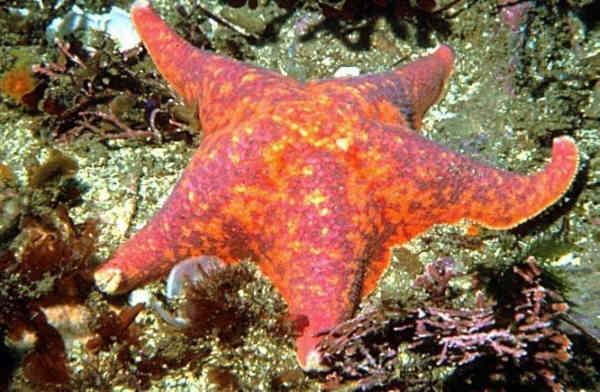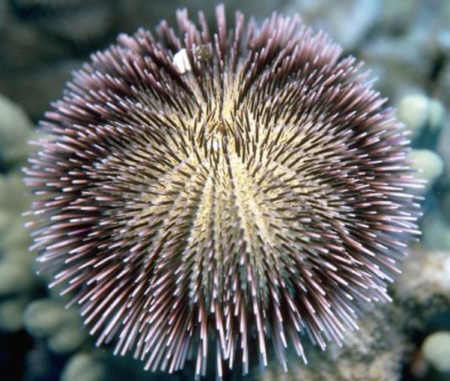|
In your kit you have several
specimens that illustrate the 5 part symmetry. Have your students compare the
top side of each of the echinoderms. The sea star and sea  cookie
have the star on their top; the sea urchin has 5 rays along the side; and the
sea star has 5 arms. Also have them look for the tiny holes in each of the
specimens, these are where the tube feet come out. There is also a big hole on
the top of each of these specimens, this is where water enters the organisms.
On the bottom you should be able to find 2 holes on the sand dollar and the
sea cookie. The middle one is where the mouth of the organism is, and the
little one is its anus. Echinoderms are more specialized than the other
specimens in your kit. They have specialized organs that perform the different
tasks for living. The sea urchin in your kit is without spines. The specimen
you have would have thin black spines, but they fall off when the organism
dies. The sea urchin spine in your kit comes from a different type of sea
urchin, different sea urchin species make different types of spines. Echinoderms live in the marine
environment and are mainly bottom dwellers.
They have a
characteristics 5 part symmetry. They also possess a unique
water pumping system that produces the water pressure which allows for the
movement of tube feet (if you put on your forearm you can feel the tub feet
moving the hairs on your skin as it moves across); they are used for
locomotion, food catching and reproduction. cookie
have the star on their top; the sea urchin has 5 rays along the side; and the
sea star has 5 arms. Also have them look for the tiny holes in each of the
specimens, these are where the tube feet come out. There is also a big hole on
the top of each of these specimens, this is where water enters the organisms.
On the bottom you should be able to find 2 holes on the sand dollar and the
sea cookie. The middle one is where the mouth of the organism is, and the
little one is its anus. Echinoderms are more specialized than the other
specimens in your kit. They have specialized organs that perform the different
tasks for living. The sea urchin in your kit is without spines. The specimen
you have would have thin black spines, but they fall off when the organism
dies. The sea urchin spine in your kit comes from a different type of sea
urchin, different sea urchin species make different types of spines. Echinoderms live in the marine
environment and are mainly bottom dwellers.
They have a
characteristics 5 part symmetry. They also possess a unique
water pumping system that produces the water pressure which allows for the
movement of tube feet (if you put on your forearm you can feel the tub feet
moving the hairs on your skin as it moves across); they are used for
locomotion, food catching and reproduction.
 The students have 4 representatives that illustrate the 5 part symmetry
including sea cookie, sea star, sand dollar, and sea urchin.
Have your students compare the top side of each of the echinoderms.
The sea star, sand dollar, and sea cookie have the star on their top;
the sea urchin has 5 rays along the side; and the sea star has 5 arms.
Also have them look for the tiny holes in each of the specimens, these
are where the tube feet come out. There
is also a big hole on the top of each of these specimens, this is where water
enters the organisms. On the
bottom you should be able to find 2 holes on the sand dollar and the sea
cookie. The middle one is where
the mouth of the organism is, and the little one is its anus.
Echinoderms are more specialized than the other representatives in your
kit. They have specialized organs
that perform the different tasks for living.
The sea urchin in your kit is without spines. The specimen you have would have thin black spines, but they
fall off when the organism dies. The sea urchin spine in your kit comes from a
different type of sea urchin, different sea urchin species make different type
of spines.
The students have 4 representatives that illustrate the 5 part symmetry
including sea cookie, sea star, sand dollar, and sea urchin.
Have your students compare the top side of each of the echinoderms.
The sea star, sand dollar, and sea cookie have the star on their top;
the sea urchin has 5 rays along the side; and the sea star has 5 arms.
Also have them look for the tiny holes in each of the specimens, these
are where the tube feet come out. There
is also a big hole on the top of each of these specimens, this is where water
enters the organisms. On the
bottom you should be able to find 2 holes on the sand dollar and the sea
cookie. The middle one is where
the mouth of the organism is, and the little one is its anus.
Echinoderms are more specialized than the other representatives in your
kit. They have specialized organs
that perform the different tasks for living.
The sea urchin in your kit is without spines. The specimen you have would have thin black spines, but they
fall off when the organism dies. The sea urchin spine in your kit comes from a
different type of sea urchin, different sea urchin species make different type
of spines.
KEY POINTS:
- live in seawater, mainly bottom dwellers including sea stars,
sea urchins, sand dollars
- have five part symmetry
- all have internal skeleton
- unique water pumping system that produces the water pressure which
allows for the movement of tube feet (if you put on your forearm you
can feel the tub feet moving the hairs on your skin as it moves
across); they are used for locomotion, food catching and
reproduction.
|
|